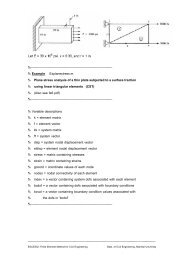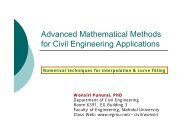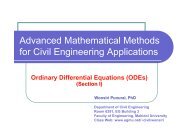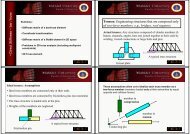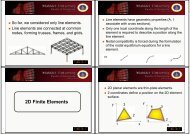Full Scale Load Testing BPEX Project, Maptaphut Rayong
Full Scale Load Testing BPEX Project, Maptaphut Rayong
Full Scale Load Testing BPEX Project, Maptaphut Rayong
- No tags were found...
You also want an ePaper? Increase the reach of your titles
YUMPU automatically turns print PDFs into web optimized ePapers that Google loves.
2 LOAD TESTING PROGRAM2.1 TESTING PROTOCOL AND ACCEPTANCE CRITERIAThe procedure used for conducting load tests in concrete structures is described inchapter 20 of ACI 318 “Strength Evaluation of Existing Structures.” In summary, thechapter provides guidance on establishing the magnitude of the test load andevaluating of the results. It suggests that the test load be placed in stages, toeliminate impact and to allow the structure some time to deform under the load.After recording of the base reading (which shall be taken not more than 1 hr beforeloading), the load is typically applied in increments of 25% of the full test load (fouror more equal increments approximately) every hour. The deflections are measuredafter each load increment and after the full test load is in place. At the end of a 24 hrholding period, another set of deflection measurements are taken and the test loadis then removed. The deflection recovery or the residual deflection is measured aftera 24‐hour rest period. This is to permit at least some time dependent effects such ascreep and load redistribution within the structural system to occur and if they aresignificant to become apparent and measurable.According to ACI 318‐08, the total test load should not be less than1.15D+1.5L‐1.0D = 0.15D+1.5Lwhere D is the dead load and L is the live load on the structure<strong>Load</strong> tests for both uniform and concentrated loading can be performed. The testcan be conducted using piled up sandbags, steel bundles or concrete blocks.ACI 318 deems the test satisfactory if the structure does not show any evidence offailure (spalling and crushing of compression zone concrete) and if the measureddeflections of the member satisfy any of the following two limitsΔΔ2≤ l t/ 20,000h≤ Δ / 4maxrmaxwhere Δmaxis the maximum displacement measured during application of the testload relative to the initial position no more than 1 hour prior to the application ofthe test load, l tis the member’s span length under the test load and h is its overallthickness or height of the member being tested. Δr is the residual deflection‐ themaximum displacement measured 24 hour after removal of the test load relative tothe initial position.If the test fails to meet these two criteria, the code allows a repetition of the test,which can be performed not earlier than 72 hr after the initial load of the first test is2




